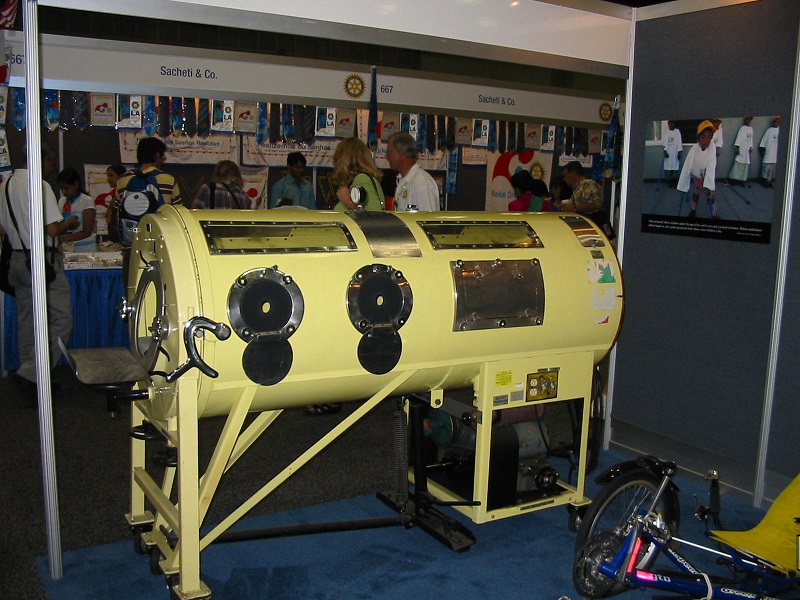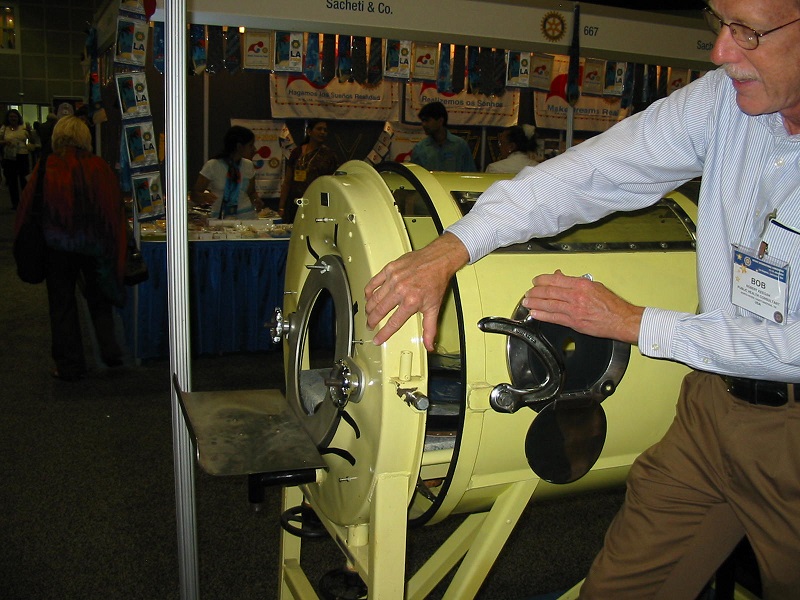
I am a 66 year-old Post-Polio patient who had Polio during a Texas epidemic in the summer of 1958. I am one of the fortunate ones who survived the Iron Lung, regained the ability to breath on my own, regained mobility and had the best medical care available at the time. Unfortunately, Post-Polio has been a part of my life for at least the past 45 years. I am a member of Grand Lake Rotary, but live in Brewton, Alabama during the winter months since I do not function at my best during cold weather.
In late May, 1958 after my first grade year in Elementary School in Dublin, Texas, I contracted Bulbar Polio. I believe that I contracted the disease after wading and splashing in a creek near our home which contained stagnant water. Within a couple of days, I began experiencing influenza-like symptom with headache and fever. Soon, paralysis began which our family doctor determined to be the onset of Polio. My father carried me to the family automobile and my parents drove me to Fort Worth, to Cook's Children Hospital. My pediatrician met us there, and tests were begun to determine the cause of my illness. After a painful spinal tap to obtain spinal fluid, the diagnosis was confirmed. I was then transferred to John Petersmith Hospital, where Catholic nuns were caring for Polio victims. We were quarantined and put in wards with other children with the disease.
Soon, it was determined that I could not breathe on my own, and I was placed in an "iron lung", perhaps the most frightening part of my overall experience. My world was reduced to a metal cylinder with a mirror above my head in which I viewed what went on around me. I can only imagine what my poor parents were thinking about my situation; I did not see my parents while I was in the hospital during what was considered the contagious stage of Polio. I have very few memories of this time in my illness beyond the kindnesses of the nuns who floated through the ward in long black habits.
 Summers in Texas are hot and the hospital had no air conditioning. The days were miserable confined in those breathing machines between the heat of summer and the constant noise which the machine made. Periodically, the nuns would remove me from the iron lung to change the sheets and diapers. At some point, one nurse noticed that I was making an effort to breath on my own. I cannot say at what point in my hospitalization this took place...days or weeks all seemed the same. I was gradually weened away from the iron lung and moved from the ward; as it was determined that I might have some sort of recovery.
Summers in Texas are hot and the hospital had no air conditioning. The days were miserable confined in those breathing machines between the heat of summer and the constant noise which the machine made. Periodically, the nuns would remove me from the iron lung to change the sheets and diapers. At some point, one nurse noticed that I was making an effort to breath on my own. I cannot say at what point in my hospitalization this took place...days or weeks all seemed the same. I was gradually weened away from the iron lung and moved from the ward; as it was determined that I might have some sort of recovery. At some point, physical therapy which was available at that time was implemented, using the methods of Sister Kenny. Some of the rehabilitation would have been better suited to adults but methods at the time did not differentiate between ages. I weighed only 40 pounds by the time I had begun to recover and had limited use of my arms and legs. One of the parts of therapy that I really hated was being put in a Mae West style life preserver and placed in an adult depth whirlpool bath. The water was far too hot for my frail body and I was left alone to float around like a bobbing cork in the whirlpool - I was terrified. Orderlies were charged with administering hot packs which consisted of felt pads which were brought to my bedside in a rolling autoclave. The pads were so hot that the orderlies could not handle them and used tongs to drape them on my arms and legs. As I lay under the steaming felt pads, plastic material (like shower curtains) were placed on top to prevent the heat from escaping. It was perfectly miserable and I think that the whole process did little to improve my overall condition. I do believe that it affected me emotionally and I did have some residual problems to overcome.
Manual manipulation of my extremities was beneficial and I believe that type of rehabilitation did make a difference. Late in the summer of 1958, I was recovered enough to be released from the hospital in Fort Worth, Texas. My parents took the responsibility of caring for me at home. I gradually improved and regained the strength needed to walk and to use my limbs. My recovery seemed so miraculous that I was ready to return to school with my classmates in September, 1958. I recall that my pediatrician, Dr. Blanche O. Terrell, told my mother that there might be issues later in life; however, there did not appear to be any residual Polio symptoms. I did have time of fatigue and muscles that ached after exercise but that seemed minor when my parents considered what I had come through.
During grade school, junior high, and high school, I was active and seemed to have little if any problems. By college, I had begun to have unexplained periods of fatigue that I could not overcome as well as breathing issues, asthma, and joint and muscle pain. An afternoon nap was sufficient to power through most issues. By the time I was 30, I had muscle pain on my left side that was almost constant, and muscles that would randomly twitch all over my body. Even though all of my doctors knew that I was a Polio survivor, none seemed to see a connection between that and my developing health concerns. I went from one specialist to another without any conclusive diagnosis. One thought I had the beginnings of MS; another ALS; another prescribed heavy doses of pain medication that had problems of its own.
It would be ten years before the term Post-Polio would be applied to those of us who had survived the disease. Several medical professionals have treated me for a litany of related problems and I have a regimen which seems to work well-enough for me. The condition is not curable; not really treatable. One just lives with it and treats the complications, such as breathing issues related to the nerve and muscle damage to the diaphragm; also, limbs that do not always respond to nerve impulses. It is an interesting challenge. I have far exceeded the expectations of the medical community of 1958, when it was assumed that I would never breathe on my own again, let alone walk. Miracles do happen.
The permanent eradication of Polio in all of its forms is such an important undertaking. All of the world will benefit from the accomplishment of this project. Preventing the life-long suffering, permanent crippling of children and adults worldwide. I am so very grateful for the leadership and participation of Rotary in this undertaking.
I have never really discussed my polio experiences to any degree, except with my doctors. As a senior, I am probably more comfortable to think about it now that I have been at other times in my life. Best wishes, Bob Scott, bobvscott@yahoo.com